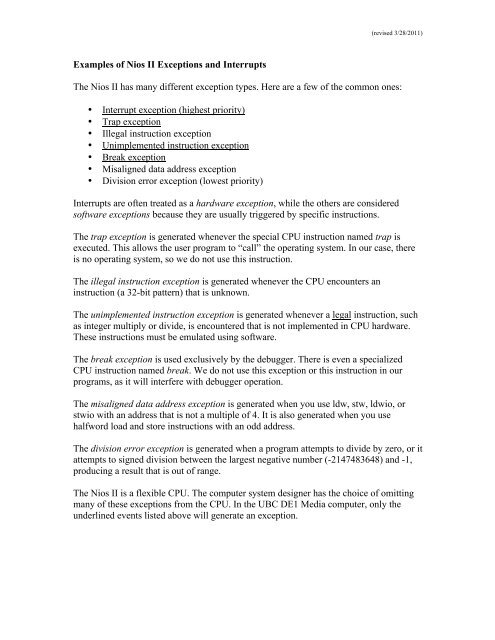L33-L38 Nios II Interrupts without LQuiz - Courses
L33-L38 Nios II Interrupts without LQuiz - Courses
L33-L38 Nios II Interrupts without LQuiz - Courses
Create successful ePaper yourself
Turn your PDF publications into a flip-book with our unique Google optimized e-Paper software.
Examples of <strong>Nios</strong> <strong>II</strong> Exceptions and <strong>Interrupts</strong><br />
(revised 3/28/2011)<br />
The <strong>Nios</strong> <strong>II</strong> has many different exception types. Here are a few of the common ones:<br />
• Interrupt exception (highest priority)<br />
• Trap exception<br />
• Illegal instruction exception<br />
• Unimplemented instruction exception<br />
• Break exception<br />
• Misaligned data address exception<br />
• Division error exception (lowest priority)<br />
<strong>Interrupts</strong> are often treated as a hardware exception, while the others are considered<br />
software exceptions because they are usually triggered by specific instructions.<br />
The trap exception is generated whenever the special CPU instruction named trap is<br />
executed. This allows the user program to “call” the operating system. In our case, there<br />
is no operating system, so we do not use this instruction.<br />
The illegal instruction exception is generated whenever the CPU encounters an<br />
instruction (a 32-bit pattern) that is unknown.<br />
The unimplemented instruction exception is generated whenever a legal instruction, such<br />
as integer multiply or divide, is encountered that is not implemented in CPU hardware.<br />
These instructions must be emulated using software.<br />
The break exception is used exclusively by the debugger. There is even a specialized<br />
CPU instruction named break. We do not use this exception or this instruction in our<br />
programs, as it will interfere with debugger operation.<br />
The misaligned data address exception is generated when you use ldw, stw, ldwio, or<br />
stwio with an address that is not a multiple of 4. It is also generated when you use<br />
halfword load and store instructions with an odd address.<br />
The division error exception is generated when a program attempts to divide by zero, or it<br />
attempts to signed division between the largest negative number (-2147483648) and -1,<br />
producing a result that is out of range.<br />
The <strong>Nios</strong> <strong>II</strong> is a flexible CPU. The computer system designer has the choice of omitting<br />
many of these exceptions from the CPU. In the UBC DE1 Media computer, only the<br />
underlined events listed above will generate an exception.

















